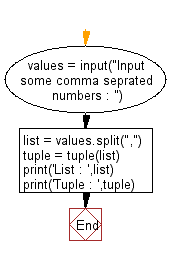Python: Generate a list and tuple with comma-separated numbers
Python Basic: Exercise-6 with Solution
Write a Python program which accepts a sequence of comma-separated numbers from user and generate a list and a tuple with those numbers.
Sample data: 3, 5, 7, 23
Python list:
A list is a container which holds comma separated values (items or elements) between square brackets where items or elements need not all have the same type. In general, we can define a list as an object that contains multiple data items (elements). The contents of a list can be changed during program execution. The size of a list can also change during execution, as elements are added or removed from it.
Python tuple:
A tuple is container which holds a series of comma separated values (items or elements) between parentheses such as an (x, y) co-ordinate. Tuples are like lists, except they are immutable (i.e. you cannot change its content once created) and can hold mix data types.
Sample Solution:-
Python Code:
values = input("Input some comma seprated numbers : ")
list = values.split(",")
tuple = tuple(list)
print('List : ',list)
print('Tuple : ',tuple)
Sample Output:
Input some comma seprated numbers : 3,5,7,23
List : ['3', '5', '7', '23']
Tuple : ('3', '5', '7', '23')
Flowchart:

Visualize Python code execution:
The following tool visualize what the computer is doing step-by-step as it executes the said program:
Python Code Editor:
Have another way to solve this solution? Contribute your code (and comments) through Disqus.
Previous: Write a Python program which accepts the user's first and last name and print them in reverse order with a space between them.
Next: Write a Python program to accept a filename from the user and print the extension of that.
What is the difficulty level of this exercise?
Test your Programming skills with w3resource's quiz.
Python: Tips of the Day
Find current directory and file's directory:
To get the full path to the directory a Python file is contained in, write this in that file:
import os dir_path = os.path.dirname(os.path.realpath(__file__))
(Note that the incantation above won't work if you've already used os.chdir() to change your current working directory, since the value of the __file__ constant is relative to the current working directory and is not changed by an os.chdir() call.)
To get the current working directory use
import os cwd = os.getcwd()
Documentation references for the modules, constants and functions used above:
- The os and os.path modules.
- The __file__ constant
- os.path.realpath(path) (returns "the canonical path of the specified filename, eliminating any symbolic links encountered in the path")
- os.path.dirname(path) (returns "the directory name of pathname path")
- os.getcwd() (returns "a string representing the current working directory")
- os.chdir(path) ("change the current working directory to path")
Ref: https://bit.ly/3fy0R6m
- New Content published on w3resource:
- HTML-CSS Practical: Exercises, Practice, Solution
- Java Regular Expression: Exercises, Practice, Solution
- Scala Programming Exercises, Practice, Solution
- Python Itertools exercises
- Python Numpy exercises
- Python GeoPy Package exercises
- Python Pandas exercises
- Python nltk exercises
- Python BeautifulSoup exercises
- Form Template
- Composer - PHP Package Manager
- PHPUnit - PHP Testing
- Laravel - PHP Framework
- Angular - JavaScript Framework
- Vue - JavaScript Framework
- Jest - JavaScript Testing Framework
